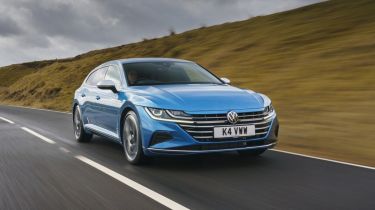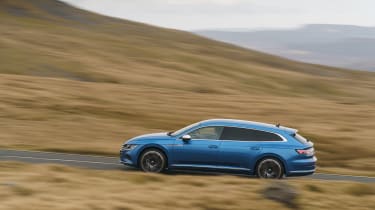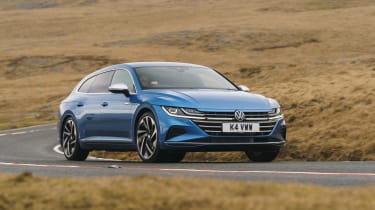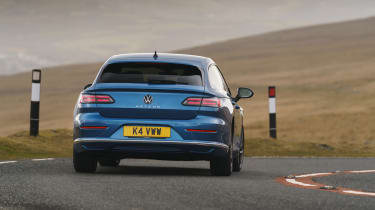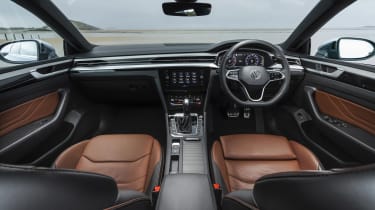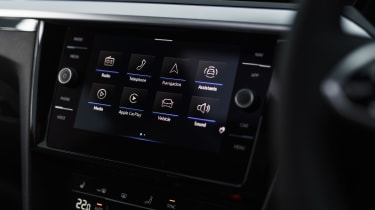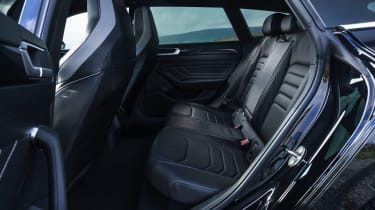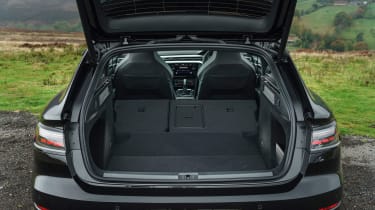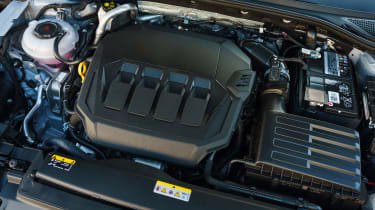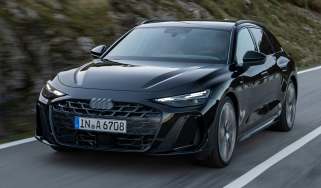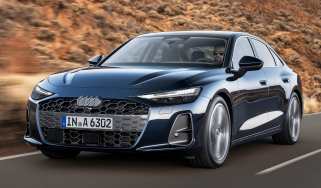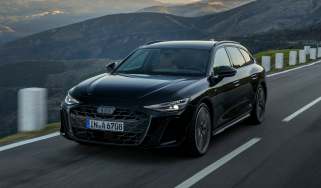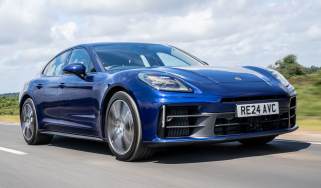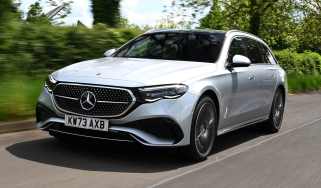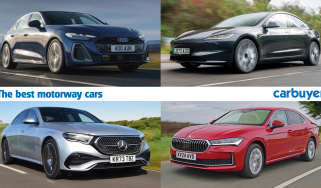Volkswagen Arteon Shooting Brake estate review
"The handsome Volkswagen Arteon Shooting Brake is a stylish alternative to more traditional estates"
Pros
- Practical
- Attractive design
- Strong engine range
Cons
- Slightly firm ride
- Unengaging to drive
- Fiddly touch-sensitive controls
The Volkswagen Arteon Shooting Brake is a stylish take on the estate formula, one that's seeking to inject some glamour into an area of the market often billed as boring. With sleek looks, it could indeed tempt some buyers away from a crossover or SUV.
In its own class, the Shooting Brake faces tough competition because it competes with not only the Audi A4 Avant but also the Mercedes C-Class Estate and BMW 3 Series Touring. Those cars have been honed over many generations, so the newcomer is more of a left-field choice. Its merits include those fantastic looks, along with a bigger boot than most rivals.
The Arteon isn’t actually quite as new as it might seem because the car is based on the Passat, and is offered with a similar range of engines, from a 1.5-litre petrol to 2.0-litre petrol and diesel engines, or a petrol-electric plug-in hybrid (PHEV) powertrain. The smaller engine will suit many private buyers, while the diesel is our pick for motorway drivers. The PHEV also makes lots of sense for company-car and business owners, thanks to its very low CO2 emissions of 26g/km. Not only does this make it liable for lower monthly bills, it can also enter low emissions zones tariff-free.
More reviews
In-depth reviews
While performance won't be lacking for most drivers, the Arteon Shooting Brake can't match the BMW for driving thrills. The Passat-based Arteon lacks the sophisticated rear-wheel drive setup of the 3 Series Touring and not only does it lean more in corners, it also feels rather firm on poor road surfaces. Where the Arteon works best is on the motorway; not only is it comfortable at speed, its aerodynamic shape means it's also quiet.
That's unless you go for the Arteon R, which has the same 316bhp engine and clever four-wheel-drive system as the Golf R Estate. This rockets from 0-62mph in 4.9 seconds and offers plenty of performance and grip.
The interior is well finished and even in the entry-level SE Nav trim there's plenty of kit, including three-zone climate control, LED lighting and adaptive cruise control. Elegance adds some attractive features and larger wheels, while Dynamic Chassis Control brings selectable driving modes that alter how the car feels. The top R-Line trim gives the VW its sportiest looks, thanks to 19-inch alloys and a makeover inside and out.
 Best estate cars on sale in 2025
Best estate cars on sale in 2025
We applaud Volkswagen for trying something different with the Arteon Shooting Brake - it's an attractive alternative to a Passat Estate, or even an SUV. However, VW has traditionally struggled when taking on upmarket rivals and when compared against a BMW 3 Series Touring, it's clear the Arteon Shooting Brake has a tough job on its hands.
MPG, running costs & CO2
At the more affordable end of the Arteon lineup, there's a 1.5-litre petrol engine that returns up to 41.9mpg and CO2 emissions of 153g/km. This is likely to be the top pick for private buyers but company-car drivers may well be put off by that CO2 figure, as it results in a high Benefit-in-Kind (BiK) tax liability.
An alternative is the 2.0-litre diesel and, while the fuel has been declining in popularity, it makes sense for large cars like the Arteon Shooting Brake, which are likely to rack up lots of motorway miles. The 148bhp version returns up to 54.5mpg and emits 136g/km of CO2. Buyers can also opt for a more potent 197bhp version, which only results in slightly lower efficiency.
Picking the 2.0-litre TSI petrol engine has a more significant effect on running costs, cutting consumption to around 40mpg, which will be tricky to achieve if you aren't gentle with the accelerator. The Arteon R is even thirstier, managing just 31mpg while emitting 209g/km of CO2.
The best option for business drivers is likely to be the plug-in hybrid. This uses Volkswagen's familiar 1.4-litre petrol-electric powertrain with a combined 215bhp and CO2 emissions of just 27g/km, making it a low BiK car that can also drive into low emissions zones like the London Congestion Charge for free.
Engines, drive & performance
We tested the 2.0-litre TSI petrol with 187bhp, giving it a respectable 0-62mph acceleration time of 7.8 seconds. Not bad considering the Arteon Shooting Brake's large size and the engine feels like it has plenty of pulling power.
The steering and handling aren't especially satisfying once you leave the motorway, however. Here the Volkswagen is well and truly beaten by the BMW 3 Series Touring, because not only is the Arteon's steering lacking in feedback, the suspension can also feel somewhat brittle and unsophisticated over harsh road surfaces.
Despite feeling firm, the Arteon also leans more in corners than the BMW, and its DSG automatic gearbox isn't as smooth. The steering wheel paddles make driving a little more involving but switching between different driving modes does little to improve the handling.
The 2.0-litre TDI diesel engine arguably suits the Arteon even better, with either 148bhp or 187bhp. These are ideal for sitting on the motorway for long periods of time, easily overtaking slower traffic and turning over quietly at a cruise.
WIth the same 316bhp 2.0-litre petrol engine from the Volkswagen Golf R and Tiguan R, the Arteon R Shooting Brake is predictably quick. Acceleration from 0-62mph is dealt with in just 4.9 seconds, while its top speed is electronically limited to 155mph. It's a flexible, muscular engine too, even if not quite as characterful as the six-cylinder engine in the BMW M340i Touring. The automatic gearbox shifts smoothly in its most relaxed mode but choose R mode or take manual control using the steering wheel paddles, and shifts are sharper and more precise.
It might be quite a bit longer than the Golf R but the Arteon R still turns and grips with tenacity, aided by the security and torque-vectoring capabilities of its four-wheel-drive system. Negatives are the steering, which offers little feedback, and the fact the R Shooting Brake isn't as playful as the Golf R; it feels a little more grown up and less keen to tighten its cornering line when you come off the throttle.
Interior & comfort
The Arteon Shooting Brake makes a strong case for itself on the motorway, especially if the optional acoustic pack is fitted. This adds sound-insulated glass and extra sound deadening to make the VW even more hushed inside, and the Arteon's sleek shape means there's very little wind noise at the national speed limit.
Materials are generally of a high quality but, as with the Volkswagen Golf, we think the touch sensitive controls for the climate control is a backwards step - they just aren't as easy to use while on the move. The infotainment and instrument displays look reasonably sharp but they aren't quite as big as the same items in the BMW 3 Series Touring, and we don't find the software quite as intuitive either.
Trim levels are SE Nav - that feels squarely aimed at business drivers - Elegance and R-Line. Standard equipment is generous, including 17-inch alloy wheels, LED headlights, three-zone climate control, adaptive cruise control and an eight-inch touchscreen. Elegance brings 18-inch alloy wheels, adaptive suspension dampers, selectable driving modes and heated front seats.
R-Line gives the Arteon Shooting Brake a different look again, introducing 19-inch alloy wheels and a different body styling kit. The interior looks different too, thanks to a black headliner, sports seats with R-Line logos and a panoramic sunroof.
The Arteon R Shooting Brake is effectively its own trim level, with exterior styling features including 19-inch alloy wheels, silver door mirror caps, a subtle body kit and four exhaust pipes. Inside, there’s carbon fibre trim, Nappa leather heated and massaging seats, a panoramic sunroof, a heated steering wheel and keyless entry.
Practicality & boot space
The Arteon Shooting Brake offers some extra room compared with the hatchback, thanks to an elongated roof that doesn't slope as quickly. Even tall passengers should have plenty of headroom and space for their legs in the back, making it a comfortable car for all passengers.
Boot space behind the rear seats also increases, coming in at 590 litres, even for the hot R version. That's more than the BMW 3 Series Touring, Audi A4 Avant and Mercedes C-Class Estate can offer, and it's conveniently accessed via a powered tailgate that can recognise a waving foot under the bumper. Levers just inside the boot can be used to fold down the split-folding rear seats, so you don't have to run around to the back doors. It also expands luggage capacity to just over 1,600 litres.
Towing capacity is an impressive 1,600kg to 2,200kg for a braked trailer, making the VW ideal for hauling a caravan or trailer.
Reliability & safety
It might be a new model but the Arteon is based on the same underpinnings as the Volkswagen Passat and uses engines familiar across the Volkswagen Group family. While that should offer reassurance to buyers, it's also worth noting that Volkswagen's scores in our 2020 Driver Power survey were only middling, with 20.2% of owners reporting a fault within the first 12 months.
The hatchback version of the Arteon performed well in Euro NCAP crash tests, however, with an impressive 96% for adult occupant protection and 85% for child occupants. This helped it achieve five stars overall and it comes with a wide range of safety equipment as standard. Autonomous emergency braking helps the estate avoid collisions, and features like lane assist with road edge detection are standard, along with all-round parking sensors and automatic headlights.

